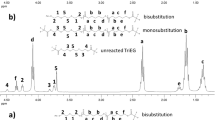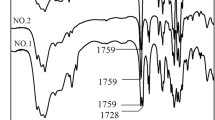Abstract
The solid-state degradation of poly(ε-caprolactone) catalyzed by primary, secondary and tertiary alkylamines was investigated. The degradation process was monitored by weight loss and molecular weight change measured by gel permeation chromatography. Degradation studies were conducted at 37°C in methanol solutions of the alkylamines. Primary alkylamines caused rapid weight loss (i.e., ~90% weight loss in 30 days) that depended on alkylamine concentration, molar ratio of alkylamine to poly(ε-caprolactone) monomer and alkyl chain length. The secondary alkylamines caused less rapid polymer weight loss (i.e., ~90%) weight loss within 80 days). One tertiary alkylamine (N,N-diisopropylethylamine) showed little catalytic effect while a bicyclic tertiary alkylamine (quinuclidine) was about as catalytic as the primary alkylamines. The degradation products isolated when primary alkylamines were used include both esters and amides indicating that nucleophilic attack by the alkylamines competed with the amine-catalyzed methanolysis reaction. Only ester moieties could be identified in the products from reactions containing secondary and tertiary alkylamines, which indicated that they acted as nucleophilic catalysts. All of the primary alkylamines reduced poly(ε-caprolactone) molecular weight from about 25,000 to 10,000 within 10 days after which the molecular weight of the remaining solid leveled off even though weight loss continued.
Similar content being viewed by others
REFERENCES
H. T. Wang, H. Palmer, R. J. Linhardt, D. R. Flanagan and E. Schmitt. Degradation of poly(ester) microspheres. Biomaterials 11:679–695 (1990).
H. T. Wang, E. Schmitt, D. R. Flanagan, and R. J. Linhardt. Influence of formulation methods on the in vitro controlled release of protein from poly(ester) microspheres. J. Control. Release 17:23–32 (1991).
E. A. Schmitt, D. R. Flanagan, and R. J. Linhardt. Degradation and release properties of pellets fabricated from three commercial poly(D,L-lactide-co-glycolide) biodegradable polymers. J. Pharm. Sci. 82:326–329 (1993).
H. T. Wang, H. Palmer, R. J. Linhardt, D. R. Flanagan and E. Schmitt. Controlled release of protein and vaccines from poly(ester) microspheres in vitro. in Cosmetic and Pharmaceutical Applications of Polymers. Amer. Chem. Soc. Symp. Ser. C. G. Gebelein, V. C. Yang (Eds). Plenum, New York, 239–253 (1992).
E. A. Schmitt, D. R. Flanagan, and R. J. Linhardt. Biodegradable polymers for the controlled delivery of vaccines. in Biotechnology and Bioactive Polymers. C. G. Gebelein, and C. E. Carraher (Eds). Plenum, New York. 249–258 (1993).
A. K. Banga, and Y. W. Chien. Systemic delivery of therapeutic peptides and proteins. Int. J. Pharm. 48:15–50 (1988).
S. Cohen, T. Yoshioka, M. Lucarelli, L. H. Hwang, and R. Langer. Controlled delivery systems for proteins based on poly(lactic/glycolic acid) microspheres. Pharm. Res. 8:713–720 (1991).
D. Bodmer, T. Kissel, and E. Traechslin. Factors influencing the release of peptides and proteins from biodegradable parenteral depot systems. J. Control. Release 21:129–138 (1992).
M. J. Alonso, S. Cohen, T. G. Park, R. K. Gupta, G. R. Siber, and R. Langer. Determinants of release rate of tetanus vaccine from polyester microspheres. Pharm. Res. 10:945–953 (1993).
C. Dubernet, J. P. Benoit, G. Couarraze, and D. Duchene. Microencapsulation of nitrofurantoin in poly(ε-caprolactone): tableting and in vitro release studies. Int. J. Pharm. 35:145–156 (1987).
N. J. Medlicott, D. S. Jones, I. G. Tucker, and D. Holborow. Preliminary release studies of chlorhexidine (base and diacetate) from poly(ε-caprolactone) films prepared by solvent evaporation. Int. J. Pharm. 84:85–89 (1992).
L. Marchal-Heussler, D. Sirbat, M. Hoffman, and P. Maincent. Poly(ε-caprolactone) nanocapsules in carteolol ophthalmic delivery. Pharm. Res. 10:386–390 (1993).
J. Heller. Biodegradable polymers in controlled drug delivery. Crit. Rev. Ther. Drug Carrier Syst. 1:39–90 (1984).
R. J. Linhardt. Biodegradable polymers for controlled release of drugs. in Controlled release of drugs: polymers and aggregate systems M. Rosoff (Ed). New York. 53–96 (1988).
C. G. Pitt, Zhong-wei Gu. Modification of the rates of chain cleavage of poly(ε-caprolactone) and releated polyesters in the solid state. J. Control. Release 4:283–292 (1987).
M. D. Coffin, and J. W. McGinity. Biodegradable pseudolatexes: the chemical stability of poly(D,L-lactide) and poly(ε-caprolactone) nanoparticles in aqueous media. Pharm. Res. 9:200–205 (1992).
K. Makino, M. Arakawa, and T. Kondo. Preparation and in vitro degradation properties of polylactide microcapsules. Chem. Pharm. Bull. 33:1195–1201 (1985).
Y. Cha, and C. G. Pitt. The acceleration of degradation-controlled drug delivery from polyester microspheres. J. Control. Release 8:259–265 (1989).
Colin G. Pitt, A. R. Jeffcoat, R. A. Zweidinger, and A. Schindler. Sustained drug delivery systems I. the permeability of poly(ε-caprolactone), poly(DL-lactic acid), and their copolymers. J. Biomed. Mater. Res. 13:497–507 (1979).
C. G. Pitt, M. M. Gratzl, A. R. Jeffcoat, R. Zweidinger, and A, Schindler. Sustained drug delivery systems II: factors affecting release rates from poly(ε-caprolactone) and related biodegradable polyesters. J. Pharm. Sci. 68:1534–1538 (1979).
C. G. Pitt, F. I. Chasalow, Y. M. Hibionada, and A. Schindler. Aliphatic polyesters I. the degradation of poly(ε-caprolactone) in vivo. Journal of Applied Polymer Science 26:3779–3787 (1981).
Colin G. Pitt. Poly-ε-caprolactone and its copolymers. in Biodegradable Polymers as Drug Delivery Systems, Mark Chasin and Robert Langer (Eds), 71–120 (1990).
N. Wakiyama, K. Juni, and M. Nakano. Preparation and evaluation in vitro of polylactic acid microspheres containing local anesthetics. Chem. Pharm. Bull. 29:3363–3368 (1981).
N. Wakiyama, K. Juni, and M. Nakano. Influence of physicochemical properties of polylactic acid on the characteristics and in vitro release patterns of polylactic acid microspheres containing local anesthetics. Chem. Pharm. Bull. 30:2621–2628 (1982).
N. Wakiyama, K. Juni, and M. Nakano. Preparation and evaluation in vitro and in vivo of polylactic acid microspheres containing dibucaine. Chem. Pharm. Bull. 30:3719–3727 (1982).
H. V. Maulding, T. R. Tice, D. R. Cowsar, J. W. Fong, J. E. Pearson, and J. P. Nazareno. Biodegradable microcapsules: acceleration of polymeric excipient hydrolytic rate by incorporation of a basic medicament. J. Control. Release 3:103–117 (1986).
Y. Cha, and C. G. Pitt. A one-week subdermal delivery system for L-methadone based on biodegradable microcapsules. J. Control. Release 7:69–78 (1988).
V. Crescenzi, G. Manzini, G. Calzolari, and C. Borri. Thermodynamics of fusion of poly-beta-propiolactone and poly-ε-caprolactone comparative analysis of the melting of aliphatic polylactone and polyester chains. Europ. Polym. J. 6:449–463 (1972).
Author information
Authors and Affiliations
Rights and permissions
About this article
Cite this article
Lin, WJ., Flanagan, D.R. & Linhardt, R.J. Accelerated Degradation of Poly(ε-caprolactone) by Organic Amines. Pharm Res 11, 1030–1034 (1994). https://doi.org/10.1023/A:1018943622498
Issue Date:
DOI: https://doi.org/10.1023/A:1018943622498




